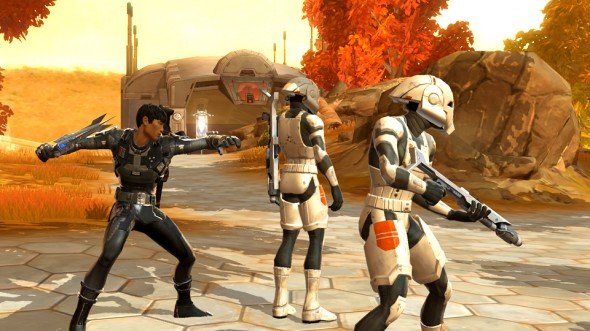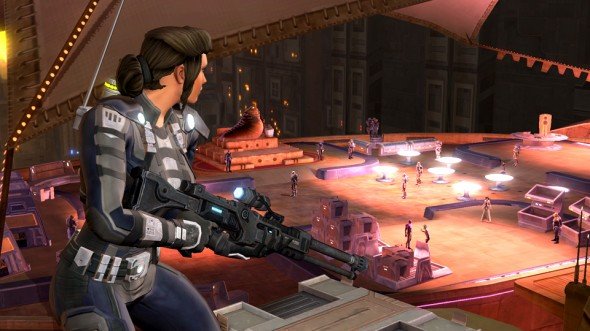Star Wars: The Old Republic: 17 hours with the Agent

It takes many types of force to impose and sustain a galaxy-wide empire. The Sith control with supernatural authority and an iron fist, and Bounty Hunters fill the ranks of their mercenary armies that wage war. But another branch of the Empire lives in the shadows, silently removing threats and toppling rulers to manipulate circumstances in the Empire's favor. At the front of this wraith-like army is the Agent, an Imperial Intelligence operative backed by the funds and resources of Star Wars' ultimate Big Brother organization as they travel the world to assassinate, infiltrate and manipulate on behalf of the Empire.
Double life
Back in March, I took a trip to BioWare's Austin office and was given the opportunity to create a brand new Agent and play him for as many hours as physically possible in two days. (Tom Francis played as a Bounty Hunter during the same demo. You can read his perspective here . Our articles were both originally published in the then-current issues of our respective magazines.)
The first thing that struck me about the Agent's starting area (a crime-infested planet called Hutta, which it shares with the Bounty Hunter class) is that the story and tasks are actually quite different from the Jedi starting area I'd played before. They do an impressive job of replicating the lifestyle of a secret agent. Within the first hour, I'd snuck onto a neutral planet, assumed a false persona to infiltrate a Hutt crime lord's palace, paid hush money to someone who knew my secret and sabotaged a power factory.
Along the way, I also did plenty of straightforward kill-and-deliver quests, but there was usually a class-specific quest guiding me through the area that added more meaning to the adventure. When I was sent to sabotage the power factory (in order to earn the trust of the Hutt's security chief and increase his status so that he'd be more useful to me), I ran into a small outpost of downtrodden locals. If I was headed into the facility anyways, why not earn a few extra credits by stealing some power generators and stomping in a few bad-guy faces for 'em?
Story time
Tales of TOR's focus on story have not been exaggerated: it's immediately apparent that this is a BioWare game. The characters are charming, pitiful, disturbing and hilarious—always interesting and brought to life by the voice-overs. My personal favorite was a jittery Imperial captain who started off our conversation by confessing that he had accidentally murdered his entire squad when they threw him a surprise birthday party, but he thought he was being ambushed.
It's this extra attention to detail that adds BioWare's signature spark to TOR's characters—even your own. When speaking with fellow Imperials, my Agent had an Imperial/British accent, but he adopted an American accent while he was undercover.
You're given opportunities to roleplay in conversations by choosing responses that are nice, neutral or evil, netting you Light or Dark side points at key junctures. The types of choices will be immediately familiar to anyone who's played a BioWare game. Here's one: a group of Imperial soldiers have been captured by a mad scientist and had their consciousnesses transferred into war machines. The last one with any humanity begs you to destroy them all. Do you oblige him and end their suffering or hand them over to the Empire to fight in the war?
The biggest gaming news, reviews and hardware deals
Keep up to date with the most important stories and the best deals, as picked by the PC Gamer team.

Your choices can sometimes affect who your quest-givers are and what you're doing for them in the open world, but the real storytelling happens within the class-specific areas of the world. These are sectioned-off portions of buildings and zones that seamlessly place you into instanced areas when you enter them. Inside these areas, you choices can have real consequences on your story and the main characters in the game.
Your companions will weigh-in during conversations too, and your choices will earn their approval or disapproval accordingly, similar to Dragon Age (although in TOR you can only have one companion with you at a time). The Agent's first companion—Kaliyo, a free-spirited, selfish assassin—reminded me a lot of DA's Morrigan: dark, sexy and disapproving of everything I did.
Taking cover
What Kaliyo and I lacked in kindred spirits, we made up for in kindred bullets. Kaliyo's bullet-spray-and-hand-grenade combat style was the perfect complement to the Agent's long-distance, precision attacks. The Agent's key combat mechanic—taking cover—is activated by holding Shift. When you do so, all nearby cover locations are highlighted in real-time; you can tap R to roll into the one you're looking at.
Cover functions fairly realistically: it isn't a flat percent-damage reduction. If you're behind it (based on line-of-sight) when someone shoots at you, it misses completely. If you're standing up and shooting at them, you're going to get hit. Cover degrades as it gets shot, and some abilities are designed specifically to shoot over cover or knock you out of it, so complacency could cost you.

In addition, you have a few abilities that can only be used while you're in cover mode, such as Snipe (a high-damage ability with a long cast time), Suppressive Fire (a channeled spray-and-pray technique that hits all targets in front of you randomly) and Explosive Probe (sends a small probe to the target that explodes the next time they're hit).
Fighting is all about rhythm: whenever I found myself pinned down behind a rock with only a sliver of health, I'd start counting the seconds between my target's attacks. Once I figured out their rhythm, I knew exactly when I could pop up, unleash one or two shots and duck behind the rock again before they could hit me. It's a fun mechanic that encourages you to react to your surroundings, instead of blindly grinding through a combat rotation.
Of course, there were plenty of times that I ignored cover and simply went all-out with the run-and-gun technique, but I usually took a heavy hit to my health when doing so (think Han Solo charging at the Stormtroopers, then promptly running away screaming in Episode IV).

